|
|
|
Sort Order |
|
|
|
Items / Page
|
|
|
|
|
|
|
| Srl | Item |
| 1 |
ID:
132687


|
|
|
|
|
| Publication |
2014.
|
| Summary/Abstract |
It is well established that GHG emissions must be reduced 50 to 80% by 2050 in order to limit global temperature increase to 2 °C. Achieving reductions of this magnitude in the transportation sector is a challenge and requires a multitude of policies and technology options. The research presented here analyzes three scenarios: changes in the perceived price of travel, land use intensification, and increases in transit. Elasticity estimates are derived using an activity-based travel model for the state of California and broadly representative of the US. The VISION model is used to forecast changes in technology and fuel options that are currently forecast to occur in the US for the period 2000-2040, providing a life-cycle GHG forecast for the road transportation sector. Results suggest that aggressive policy action is required, especially pricing policies, but also more on the technology side, especially increases in the carbon efficiency of medium and heavy-duty vehicles.
|
|
|
|
|
|
|
|
|
|
|
|
|
|
|
|
| 2 |
ID:
091698
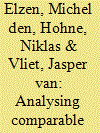

|
|
|
|
|
| Publication |
2009.
|
| Summary/Abstract |
EU Heads of State and Government agreed in March 2007 that the EU will reduce its greenhouse gas emissions to 30% below 1990 levels by 2020 within an international post-2012 climate agreement, provided that other developed (Annex I) countries commit to comparable reductions. Within this context, this paper first explores the pros and cons of many possible conceptual approaches to assess the comparability of the mitigation efforts by Annex I countries. We selected six approaches for further analysis, which represent efforts well and are technically feasible. The implications of each of these six approaches were analysed in terms of the reductions and abatement costs that must be made by different Annex I countries to meet an aggregate reduction of 20% and 30%, respectively, below 1990 levels by 2020. The analysis indicates that significant reductions are necessary for all developed countries. This study shows that reductions by the EU of at least 30%, combined with comparable reduction efforts by other developed countries to meet the aggregate Annex I reduction target of 30% by 2020 and support of developed countries for developing countries to keep their emissions 15-30% below the baseline, are sufficient to achieve the EU climate goal of 2 °C.
|
|
|
|
|
|
|
|
|
|
|
|
|
|
|
|
| 3 |
ID:
088946
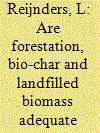

|
|
|
|
|
| Publication |
2009.
|
| Summary/Abstract |
Forestation and landfilling purpose-grown biomass are not adequate offsets for the CO2 emission from burning fossil fuels. Their permanence is insufficiently guaranteed and landfilling purpose-grown biomass may even be counterproductive. As to permanence, bio-char may do better than forests or landfilled biomass, but there are major uncertainties about net greenhouse gas emissions linked to the bio-char life cycle, which necessitate suspension of judgement about the adequacy of bio-char addition to soils as an offset for CO2 emissions from burning fossil fuels.
|
|
|
|
|
|
|
|
|
|
|
|
|
|
|
|
| 4 |
ID:
130300


|
|
|
|
|
| Publication |
2014.
|
| Summary/Abstract |
Genetically engineered (GE) foods apply new molecular technologies to agriculture. Widely adopted in the United States, Brazil and Argentina for the production of cons, soybeans, and cotton, they are practically banned in Europe and tightly regulated throughout the world. We have found that GE foods have significantly increase supplies cons, soybeans, and cotton, and lowered their prices, Thus improving food security, GE foods have already contributed to a reductions in the use of pesticides and emissions of greenhouse gases.
|
|
|
|
|
|
|
|
|
|
|
|
|
|
|
|
| 5 |
ID:
125846


|
|
|
|
|
| Publication |
2013.
|
| Summary/Abstract |
This research investigates whether where we live matters in terms of contributions to direct greenhouse gas (GHG) emissions. Using results from the Halifax Space Time Activity Research (STAR) project, we estimate GHG emissions for 1920 randomly selected respondents in Halifax Regional Municipality, Nova Scotia, Canada. The unique data set allows us to report direct GHG emissions with an unprecedented level of specificity at the sub-regional scale using household energy-use survey data and GPS-verified travel data. We report results and investigate statistical differences between communities and urban-rural zones (inner city, suburban, and inner and outer commuter belts). Results reveal considerable spatial variability in direct GHG emissions across the study area. Our findings indicate that individuals living in the suburbs generate similar amounts of GHG emissions (20.5 kg CO2e person-1 day-1) to those living in the inner city (20.2 kg CO2e person-1 day-1), challenging a widely held assumption that living in the urban centre is better for sustainability. However, individuals in more rural areas have significantly higher transport-related GHG emissions than those living in the inner city and suburbs. Our results underscore the importance of understanding the spatial distribution of GHG emissions at the sub-regional scale.
|
|
|
|
|
|
|
|
|
|
|
|
|
|
|
|
| 6 |
ID:
122720


|
|
|
|
|
| Publication |
2013.
|
| Summary/Abstract |
Most energy generation globally is fueled by coal and oil, raising concerns about greenhouse gas emissions. Hydroelectric reservoirs are anthropogenic aquatic systems that occur across a wide geographical extent, and, in addition to their importance for energy production, they have the potential to release two important greenhouse gases (GHGs), carbon dioxide and methane. We report results from an extensive study of eight hydroelectric reservoirs located in central and southeastern tropical Brazil. In the Brazilian dry tropical biome reservoirs, emissions (in tons of CO2 Eq. per MW h) varied from 0.01 to 0.55, and decreased with reservoir age. Total emissions were higher in the reservoir lake when compared to the river downstream the dam; however, emissions per unit area, in the first kilometer of the river after the dam, were higher than that in the reservoir. The results showed, despite higher carbon emissions per energy production in the youngest reservoirs, lower emission from hydroelectric reservoirs from the studied region in relation to thermo electrical supply, fueled by coal or fossil fuel. The ratio emission of GHG per MWh produced is an important parameter in evaluating the service provided by hydroelectric reservoir and for energy planning policies.
|
|
|
|
|
|
|
|
|
|
|
|
|
|
|
|
| 7 |
ID:
111770


|
|
|
| 8 |
ID:
112606
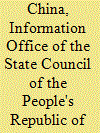

|
|
|
|
|
| Publication |
China, Foreign Languages Press, 2008.
|
| Description |
48p.Pbk
|
| Standard Number |
9787119052755
|
|
|
|
|
|
|
|
|
|
|
|
Copies: C:1/I:0,R:0,Q:0
Circulation
| Accession# | Call# | Current Location | Status | Policy | Location |
| 056463 | 363.738746/CHI 056463 | Main | On Shelf | General | |
|
|
|
|
| 9 |
ID:
112983


|
|
|
|
|
| Publication |
Washington, DC, World Bank, 2011.
|
| Description |
xiv, 306p.Pbk
|
| Standard Number |
9780821384930
|
|
|
|
|
|
|
|
|
|
|
|
Copies: C:1/I:0,R:0,Q:0
Circulation
| Accession# | Call# | Current Location | Status | Policy | Location |
| 056606 | 307.76/HOO 056606 | Main | On Shelf | General | |
|
|
|
|
| 10 |
ID:
182904
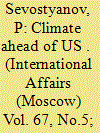

|
|
|
|
|
| Summary/Abstract |
DEPENDING on its opportunities, Russia can vary the intensity and scope of its relations with the US, Europe, the Middle East, and other participants of international relations. But we are entering a unique, new period in world history: an energy transition based on entirely new principles. Russia, as a leader of the world hydrocarbon market, cannot and should not be left out of this process...
|
|
|
|
|
|
|
|
|
|
|
|
|
|
|
|
| 11 |
ID:
092804


|
|
|
|
|
| Publication |
2009.
|
| Summary/Abstract |
Global warming and the associated changes in the world climate pattern have been accepted world wide as the gravest threat to humanity in the 20th century. To mitigate the impacts of global warming, the Kyoto Protocol was established in 1997 with the objective of reducing global greenhouse gases (GHGs) emission, in particular carbon dioxide (CO2), by 5.2% below 1990 levels. Developed nations that ratified the Protocol are committed to GHG reduction targets while developing nations are encouraged to reduce GHG emissions on a voluntary basis. Since most of the GHGs emissions come from the energy sector, energy policy plays an important role in fulfilling the Kyoto Protocol obligations. This year marks the beginning of the commitment period for the 2012 Kyoto Protocol. In this case, it would be worthwhile to compare the energy policies in Malaysia and Japan as these nations move towards fulfilling their obligations towards the Kyoto Protocol; bearing in mind that both countries ratified the Protocol, but that Japan commits a reduction target of 6% while Malaysia bears no obligation. Based on the comparison, recommendations were made on how a developing nation like Malaysia could adopt the policies implemented in Japan to suit local conditions and contribute significantly to GHG reduction.
|
|
|
|
|
|
|
|
|
|
|
|
|
|
|
|
| 12 |
ID:
109630


|
|
|
|
|
| Publication |
2011.
|
| Summary/Abstract |
Cities consumed 84% of commercial energy in China, which indicates cities should be the main areas for GHG emissions reduction. Our case study of Shenyang in this paper shows how a clear inventory analysis on GHG emissions at city level can help to identify the major industries and societal sectors for reduction efforts so as to facilitate low-carbon policy-making. The results showed total carbon emission in 2007 was 57 Mt CO2 equivalents (CO2e), of which 41 Mt CO2e was in-boundary emissions and 16 Mt CO2e was out-of-boundary emissions. The energy sector was dominant in the emission inventory, accounting for 93.1% of total emissions. Within energy sector, emissions from energy production industry, manufacturing and construction industry accounted for 88.4% of this sector. Our analysis showed that comparing with geographical boundary, setting system boundary based on single process standard could provide better information to decision makers for carbon emission reduction. After attributing electricity and heating consumption to final users, the resident and commercial sector became the largest emitter, accounting for 28.5% of total emissions. Spatial analysis of emissions showed that industrial districts such as Shenbei and Tiexi had the large potential to reduce their carbon emissions. Implications of results are finally discussed.
|
|
|
|
|
|
|
|
|
|
|
|
|
|
|
|
| 13 |
ID:
166576
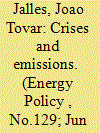

|
|
|
|
|
| Summary/Abstract |
In this paper, we empirically assess by means of the local projection method, the impact of different types of financial crises on a variety of pollutant emissions categories for a sample of 86 countries between 1980 and 2012. We find that financial crises in general lead to a fall in CO2 and methane emissions. When hit by a debt crisis, a country experiences a rise in emissions stemming from either energy related activities or industrial processes. During periods of slack, financial crises in general had a positive impact on both methane and nitrous oxide emissions. If a financial crisis hit an economy when it was engaging in contractionary fiscal policies, this led to a negative response of CO2 and production-based emissions.
|
|
|
|
|
|
|
|
|
|
|
|
|
|
|
|
| 14 |
ID:
137541
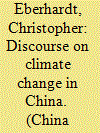

|
|
|
|
|
| Summary/Abstract |
In 2007 China passed the United States to become the greatest emitter of carbon dioxide (CO2). In the same year a report was published by the United Nations Intergovernmental Panel on Climate Change. Following this report, the Chinese media began to make a link between human activity and climate change. To analyse the climate discourse that has emerged since the publication of the report, this article draws on the argument of Guobin Yang and Craig Calhoun that China has a green public sphere. In China amid the messages to consume more are messages broadcast for the masses by the Chinese state and foreign non-governmental organizations (NGOs) advocating ‘green’ and ‘low-carbon’ lifestyles with little mention of climate change or questioning of existing policies. Smaller spaces or publics exist and are primarily occupied by governmental and non-governmental elites that debate and discuss climate change in serious and playful manners. Yet it is in spaces that are not public where policies are being crafted which influence the emissions of greenhouse gases in China, while citizens focus on their economic livelihood.
|
|
|
|
|
|
|
|
|
|
|
|
|
|
|
|
| 15 |
ID:
090039
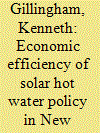

|
|
|
|
|
| Publication |
2009.
|
| Summary/Abstract |
New Zealand has recently followed the path of several other countries in promoting solar hot water (SHW) systems in the effort to reduce greenhouse gas emissions, yet the economic efficiency of large-scale policies to encourage SHW remains a pressing question for policymakers. This paper develops an economic framework to examine policies to promote SHW in New Zealand, including the current information, training, and subsidy policy. The economic framework points to environmental, energy security, and average-cost electricity retail pricing market failures as motivation for SHW policy, with the global climate change externality the most important of these. The results indicate that domestic SHW systems are close to being financially attractive from a consumer perspective, but a more substantial subsidy policy would be necessary for SHW to appeal to a wider audience. Such a policy is far more likely to have positive net benefits than a policy of mandating SHW on all homes or all new homes in New Zealand, and could be justified on economic efficiency grounds under reasonable assumptions. However, this result reverses under an economy-wide carbon trading system that internalizes the environmental externality.
|
|
|
|
|
|
|
|
|
|
|
|
|
|
|
|
| 16 |
ID:
098214


|
|
|
|
|
| Publication |
2010.
|
| Summary/Abstract |
Global concern with climate change has led to the development of a variety of solutions to monitor and reduce emissions on both local and global scales. Under the United Nations Framework Convention on Climate Change (UNFCCC), both developed and emerging countries have assumed responsibility for developing and updating national inventories of greenhouse gas emissions from anthropic sources. This creates opportunities and incentives for cities to carry out their own local inventories and, thereby, develop air quality management plans including both essential key players and stakeholders at the local level. The aim of this paper is to discuss the role of local inventories as an urban public policy instrument and how this type of local instrument may bring advantages countrywide in enhancing the global position of a country. Local inventories have been carried out in many cities of the world and the main advantage of this is that it allows an overview of emissions produced by different municipal activities, thereby, helps decision makers in the elaboration of efficient air quality management plans. In that way, measures aimed at the reduction of fossil fuel consumption to lower local atmospheric pollution levels can also, in some ways, reduce GHG emissions.
|
|
|
|
|
|
|
|
|
|
|
|
|
|
|
|
| 17 |
ID:
098547


|
|
|
|
|
| Summary/Abstract |
Global concern with climate change has led to the development of a variety of solutions to monitor and reduce emissions on both local and global scales. Under the United Nations Framework Convention on Climate Change (UNFCCC), both developed and emerging countries have assumed responsibility for developing and updating national inventories of greenhouse gas emissions from anthropic sources. This creates opportunities and incentives for cities to carry out their own local inventories and, thereby, develop air quality management plans including both essential key players and stakeholders at the local level. The aim of this paper is to discuss the role of local inventories as an urban public policy instrument and how this type of local instrument may bring advantages countrywide in enhancing the global position of a country. Local inventories have been carried out in many cities of the world and the main advantage of this is that it allows an overview of emissions produced by different municipal activities, thereby, helps decision makers in the elaboration of efficient air quality management plans. In that way, measures aimed at the reduction of fossil fuel consumption to lower local atmospheric pollution levels can also, in some ways, reduce GHG emissions.
|
|
|
|
|
|
|
|
|
|
|
|
|
|
|
|
| 18 |
ID:
166565
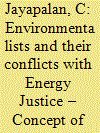

|
|
|
|
|
| Summary/Abstract |
This paper describes how a green energy surplus region changed over the years to a thermal energy-mix, driven by environmentalist forces’ strong opposition to Hydro-Electric Power Projects (HEPPs) in Kerala, India. The specific instance of the proposed Athirappilly HEPP is discussed against the background of the opposition of environmentalists and other sympathetic associations. The strong opposition to HEPPs in specific local contexts has led to increased emissions in other places. The tenets of Energy Justice – distributional, procedural, recognition and cosmopolitan – have been challenged by the environmentalists’ movement against the Athirappilly HEPP. The inherent conflicts between Environment Law and Climate Law on the one hand and the principles of Energy Justice and Law on the other are pointed out. The concept of “Power-Environ” is introduced and characterized, and its relation to Energy Justice and Law is explored in the policy context. The concept proposed here serves as a foundation for realizing parsimonious and effective representation of the opposition to HEPPs, and ushering Energy Justice and Law. The use of this concept, as an integrated whole founded on the principles of Energy Justice and Law, should facilitate balanced policy-making in the Energy sector, especially in India and hopefully across the world too.
|
|
|
|
|
|
|
|
|
|
|
|
|
|
|
|
| 19 |
ID:
094961
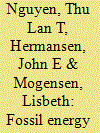

|
|
|
|
|
| Publication |
2010.
|
| Summary/Abstract |
In Europe, the highly developed livestock industry places a high burden on resource use and environmental quality. This paper examines pig meat production in North-West Europe as a base case and runs different scenarios to investigate how improvements in terms of energy and greenhouse gas (GHG) savings can be feasibly achieved. As shown in the results of the analysis, pig farming in the EU has a high potential to reduce fossil energy use and GHG emissions by taking improvement measures in three aspects: (i) feed use; (ii) manure management; and (iii) manure utilization. In particular, a combination of improvements in all mentioned aspects offers the highest savings potential of up to 61% fossil energy and 49% GHG emissions. In weighing these three aspects, manure utilization for energy production is found to be the most important factor in reducing fossil energy use and GHG emissions. However, when GHG implications of land use change and land opportunity cost associated with the production of feed crops (e.g. soy meal, cereals) are considered, reducing feed use becomes the main factor in improving GHG performance of EU pork.
|
|
|
|
|
|
|
|
|
|
|
|
|
|
|
|
| 20 |
ID:
121265
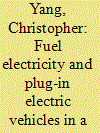

|
|
|
|
|
| Publication |
2013.
|
| Summary/Abstract |
Electricity is unique among the alternative fuels in a low carbon fuel standard (LCFS) policy, in that demand from vehicles is the major barrier to its usage, not supply. This paper presents a policy discussion and policy recommendations on a number of topics related to the regulation and incentives for fuel electricity within the LCFS. In the near-term, the LCFS will have a limited role in incentivizing the use of electricity and lowering the carbon intensity of electricity, and electricity will play a small role in meeting LCFS targets. Calculating a carbon intensity value for electricity is a complex process, requiring many decisions and trade-offs to be made, including allocation methods, system boundaries, temporal resolution and how to treat electricity demand for vehicle charging. These choices along with other regulatory decisions about who can obtain LCFS credits will influence the incentives for providing electricity and charging infrastructure relative to other low-carbon fuels as well as across different electricity providers. The paper discusses how fuel electricity would fit into an LCFS, identifying those special characteristics that could reduce the effectiveness of the policy. It also provides specific recommendations to enable better policy design that appropriately incentivizes the use of low-carbon fuels.
|
|
|
|
|
|
|
|
|
|
|
|
|
|
|
|
|
|
|
|
|